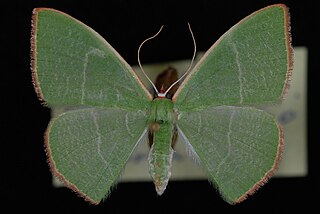
The barracuda is a ray-finned fish known for its large size, fearsome appearance and ferocious behaviour. The barracuda is a saltwater fish of the genus Sphyraena, the only genus in the family Sphyraenidae which was named by Constantine Samuel Rafinesque in 1815. It is found in tropical and subtropical oceans worldwide ranging from the eastern border of the Atlantic Ocean to the Red Sea, on its western border the Caribbean Sea, and in tropical areas of the Pacific Ocean. Barracudas reside near the top of the water and near coral reefs and sea grasses.

The lightning whelk, scientific name Sinistrofulgur perversum, is an edible species of very large predatory sea snail or whelk, a marine gastropod mollusc in the family Busyconidae, the busycon whelks. This species has a left-handed or sinistral shell. It eats mostly bivalves.

Carex leptalea is a species of sedge known by the common names bristly-stalked sedge and flaccid sedge. It is native to much of North America including most of Canada, the Dominican Republic, and the United States. It only grows in wetlands. This sedge produces dense clusters of thin stems up to 70 centimeters tall from a network of branching rhizomes. The thin, deep green leaves are soft, hairless, and sometimes drooping. The inflorescence is up to 16 millimeters long but only 2 to 3 millimeters wide, and is yellow-green in color. There are only a few perigynia on each spikelet, and they are green and veined.
- Carex leptalea subsp. harperi(Fernald) W.Stone - southeastern US from Texas and Florida north to Missouri and Pennsylvania
- Carex leptalea subsp. leptalea - widespread from Alaska east to Nunavut and south to California and Dominican Republic
- Carex leptalea subsp. pacificaCalder & Roy L.Taylor - Washington State, British Columbia, southeastern Alaska
Coccopigya spinigera is a species of sea snail, deep-sea limpet, a marine gastropod mollusk in the family Cocculinidae.
Cocculina fenestrata is a species of sea snail, deep-sea limpet, a marine gastropod mollusk in the family Cocculinidae.
Cocculina leptoglypta is a species of sea snail, deep-sea limpet, a marine gastropod mollusk in the family Cocculinidae.
Xanthodaphne leptalea is a species of sea snail, a marine gastropod mollusk in the family Raphitomidae.
Propilidium reticulatum, common name the reticulate cocculina, is a species of sea snail, a true limpet, a marine gastropod mollusk in the family Lepetidae, one of the families of true limpets.
Copulabyssia leptalea is a species of sea snail, a marine gastropod mollusk in the family Pseudococculinidae.

Choristella is a genus of sea snails, marine gastropod mollusks in the family Lepetellidae.
Copulabyssia is a genus of sea snails, marine gastropod mollusks in the family Pseudococculinidae.

Thesbia is a genus of sea snails, marine gastropod mollusks in the family Raphitomidae.
Cocculina is a genus of sea snails, deep-sea limpets, marine gastropod mollusks in the family Cocculinidae.
Onoba leptalea is a species of minute sea snail, a marine gastropod mollusk or micromollusk in the family Rissoidae.
Eulimella smithii is a species of sea snail, a marine gastropod mollusk in the family Pyramidellidae, the pyrams and their allies.
Sayella fusca, common name the brown sayella, is a species of minute sea snail, a marine gastropod mollusk or micromollusk in the family Pyramidellidae, the pyrams and their allies.

Pterois is a genus of venomous marine fish, commonly known as lionfish, native to the Indo-Pacific. Also called zebrafish, firefish, turkeyfish, tastyfish or butterfly-cod, it is characterized by conspicuous warning coloration with red, white, creamy, or black bands, showy pectoral fins, and venomous spiky fin rays. Pterois radiata, Pterois volitans, and Pterois miles are the most commonly studied species in the genus. Pterois species are popular aquarium fish. P. volitans and P. miles are a recent and significant invasive species in the west Atlantic, Caribbean Sea and Mediterranean Sea.

Anacithara is a genus of sea snails, marine gastropod mollusks in the family Horaiclavidae.

Nemoria leptalea is a species of emerald moth in the family Geometridae. It is found in Central America and North America.
Hindsiclava henekeni is an extinct species of sea snail, a marine gastropod mollusc in the family Pseudomelatomidae, the turrids and allies.









